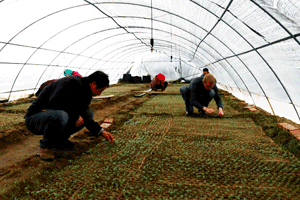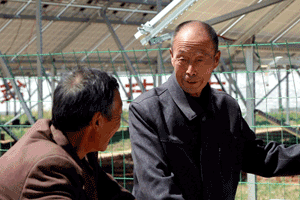No 1 Document for 2010
II. Improving the equipment level of modern agriculture to promote transformation of agricultural development patterns
6. Maintain stable development of the production of agricultural commodities such as cereal grains. While keeping the sowed areas for grains stable, more efforts are needed to optimize the variety mix, increase yield and improve quality. Implement the plan to build production capacity for an additional 100 billion jin (50 billion kg) grains and materialize the production as soon as possible. Speed up the creation of the compensation scheme for main grain-producing areas, increase fiscal reward to major grain-producing counties so as to improve the per capita fiscal capacity of these counties. Relevant support policies should lean towards counties (farms) that provide large quantity of commercial grains and contribute greatly to the nation's food security. Further reduce and ultimately eliminate local match fund requirements for grain risk funds in main grain-producing areas. Vigorously develop oil crops by building high quality rapeseed production base counties and peanut production base counties as well as promoting the development of oil trees such as oil tea and walnut. Support the production of cotton and sugar crops in areas with favorable conditions for their production. Continue to implement the "good grain harvest via science and technology" program. Scale up the production of high-yield grain, cotton, oil and sugar crops and cover all agricultural counties (state farms) within this year. Promote professional, unified pest prevention and control. Support reclamation regions to take a lead in developing modern, large scale agriculture, building large agricultural product bases and lead the economic and social development of surrounding areas.
7. Promote standardized production of "vegetable basket products." Implement a new round of "vegetable basket project" and speed up standardized production of horticultural products and large-scale production of livestock and fishery production. Support the construction of scale pig farms (parks) and dairy farms (parks), build demonstration bases for horticultural standardization and healthy fishery production, and promote integrated livestock production and processing. Support the development of breeding systems for livestock and poultry. Strengthen prevention and control of major animal diseases, improve the policy on culling subsidies, improve grassroots animal disease control systems and ensure funding for work in this regard. Increase investment on fishery administration, fishery ports and fishing boat safety devices, carry out artificial releasing of aqua species to increase production, and support ocean fishing. Speed up the development of the agricultural product quality and safety supervision and inspection system, and vigorously develop hazard-free products, green products and organic products.
8. Give priority to water resource infrastructure. Water resource infrastructure should occupy a prominent position in government fixed asset investment. Continue to strengthen the rehabilitation of major rivers and lakes and gradually push forward the rehabilitation of medium and small rivers. Speed up the construction of large - and medium-sized hydro projects and manage well the construction of flood retention areas and the prevention of flash floods. Continue with the construction of water management and water-saving facilities in large irrigation areas and expedite the construction of end-canals. Complete reinforcement of dangerous dams already included in government plans, and make arrangement for reinforcement of remaining dangerous dams. Launch the reinforcement of large-and medium-sized sluices based on scientific analysis. Expedite the upgrading and renovation of major irrigation pump stations. Expand fundraising channels for water resource projects. Greatly increase the earmarked funds for small irrigation projects from central and provincial governments. Add a number of new counties as priority counties for small irrigation projects. Encourage farmers to voluntarily contribute labor to the construction of small irrigation projects from which they will directly benefit – with government subsidies on a case-by-case basis. Deepen the reform in hydro facility management. Promote farmers' participation in management and increase government support for water-user organizations. Strengthen grassroots service systems for combating droughts, floods, and for other water resource management needs.
9. Vigorously promote the construction of high-standard farmland. Pay attention to quality improvement of farmland, increase investment and make mid-term to long-term policy loans for improving drainage and irrigation, soil rehabilitation and improvement, building roads for mechanized tillage, and building a forestry shelter along farmland. Through these measures, we aim at transforming all the "essential farmland" in the 800 major grain-producing counties into high-standard farmland and building reliable production bases for commercial grains. Continue to increase investment on comprehensive agricultural development and rural land rehabilitation, and make steady progresses in the rehabilitation of low yield land. Expand the size and coverage of subsidies for fertilizer application based on soil testing. Promote conservation tillage, carry out dry land agriculture demonstration, and provide subsidies to the application of dry land agriculture technologies.
10. Increase capacity in agricultural technological innovation and extension. Put emphasis on the breeding of good varieties and speed up the creation of good variety extension system. Continue to implement the special programs on cultivating new varieties with genetically modified organisms and develop functional genes and new varieties with high applied values and intellectual property rights. Promote industrialized production of genetically modified species on the basis of scientific evaluation and relevant laws and regulations. Promote mergers and acquisitions of domestic seed companies and guide seed companies to join hands with research institutes so as to foster large seed enterprises with core competitiveness. Cultivate leading talents in agricultural technology, and develop alliances among universities, research institutes and enterprises. Make more efforts in building major agricultural research laboratories and engineering technology centers. Implement the "science and technology for rural entrepreneurship" initiative, "science and technology for enriching farmers and strengthening counties" program, and "science education to benefit farmers and boost village economy" program. Create and strengthen township or regional agricultural extension agencies and increase the number of demonstration counties for agricultural extension reform. Actively promote the development of diverse, market-based extension organizations. Launch the "special position in grassroots agricultural extension" program to encourage college graduates with agriculture-related training to work in grassroots extension agencies. Promote technological innovations for agricultural machinery. Promote agricultural mechanization.
Vigorously promote mechanical tillage and support use of machinery in operations such as straw recycling and rice planting. Build state-level demonstration sites for modern agriculture.
11. Improve the market system for agricultural products. Formulate a national plan for wholesale markets of agricultural products, support the upgrading and renovation of major wholesale markets, implement preferential policies for agricultural wholesale markets with regard to land use, and build a large agricultural market with smooth circulation. Strengthen construction of storage facilities for agricultural commodities such as grains, cotton, oil and sugar. Improve cold chain logistics for perishable products. Provide support to large agriculture-related enterprises to build facilities for distributing agricultural products. Expedite the development of agricultural futures market, gradually increase the number of commodities traded, and encourage producers to mitigate market risks through futures trading. Encourage the use of agricultural exhibitions for marketing. Continue to implement the special program in support of upgrading 200 agricultural wholesale markets and 400 county and township markets. Promote direct connection between agricultural production bases and supermarket chains, schools and large enterprises to simplify distribution and reduce costs. Cultivate agricultural product brokers. Make full use of geographical indications and trade marks to promote agricultural product with regional features. Enhance monitoring of market trends and information services. Continue to improve the national "green passage" policy for perishable agricultural products.
12. Build a solid ecological security shield. Consolidate results achieved from the national program in converting farmland land to forest land. In ecologically fragile regions and regions of great ecological importance, increase the area for the farmland conversion in combination with poverty reduction and reservoir resettlement. Extend the implementation cycle of natural forest protection program and formulate implementation method as soon as possible. Continue with the implementation of ecological projects such as the "three north shelterbelt protection" (san bei), coastal shelterbelt protection and the Yangtze River protective forest systems, the rehabilitation of sand storms source areas in Beijing and Tianjin, as well as wetland protection and restoration programs. Coordinate the biological preservation and construction in the three-river-headwaters area in Qinghai Province. Make greater effort to raise funds for ecological benefit compensation for forest, grassland and wetland. From 2010 on, raise ecological benefit compensation standards for collectively owned public welfare forest at the national level. Establish a subsidization system for forest planting, tending, protection and management. Launch pilot programs for subsidizing planting seedlings and forest tending activities. The central budget will be allocated to subsidy the use of the production of improved forest species and tending of middle and young plantations and low yield plantations. Make plans for the protection and use of forest land, launch the forest management project, enhance forests’ ecological functions, and increase the total output of forest land. Vigorously increase forest carbon sinks. Earnestly strengthen ecological protection of grassland. Improve implementation of the "returning grazing land to grassland" program, extend program duration, and reasonably raise the subsidies. Enforce the grass-livestock balance regulations, continue to implement rotational grazing, develop livestock-raising in pens and sheds, and improve water management for fodder crop and grassland. Move ahead with the Tibet Grassland Ecological Protection Reward Mechanism pilots. Strengthen grassland rat and insects control. Strengthen the development of grassland supervision and administration system and strengthen law enforcement. Implement national priority projects for water and soil retention and speed up the rehabilitation of Karst regions in the south. Launch integrated rehabilitation of hillside farmland rehabilitation to prevent soil erosion and build clean small watersheds. Strengthen control of agricultural non-point pollution. Develop recycle agriculture and ecological agriculture.
- Typhoon Merbok to hit southern China coast Monday night
- Subgroups of BRICS brainstorm at meeting
- From imitation to innovation: China's fashion industry gets tech boost
- Nobel laureate heads Chinese institute on economics, AI application eyed
- Altay's isolation from railway network comes to an end



















